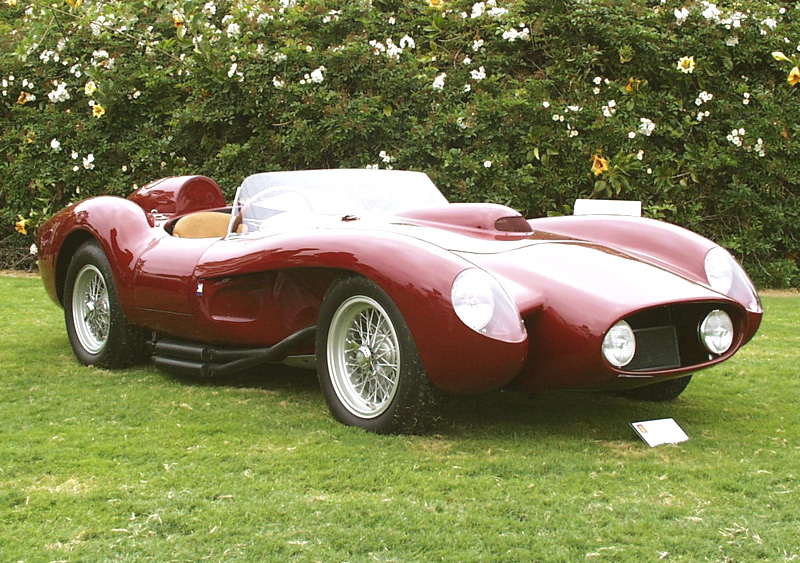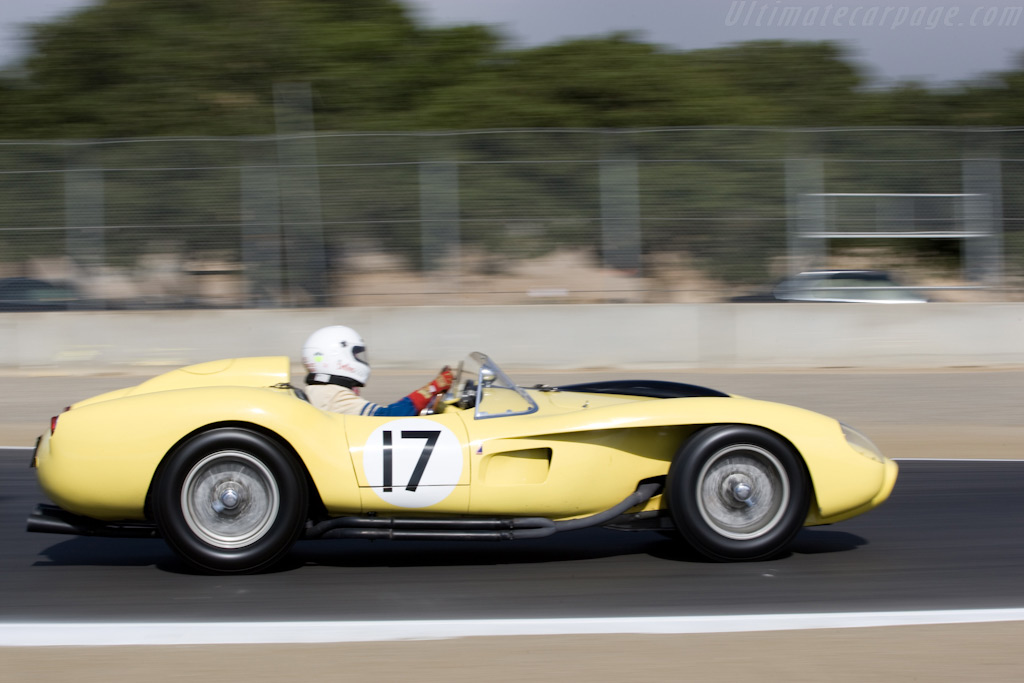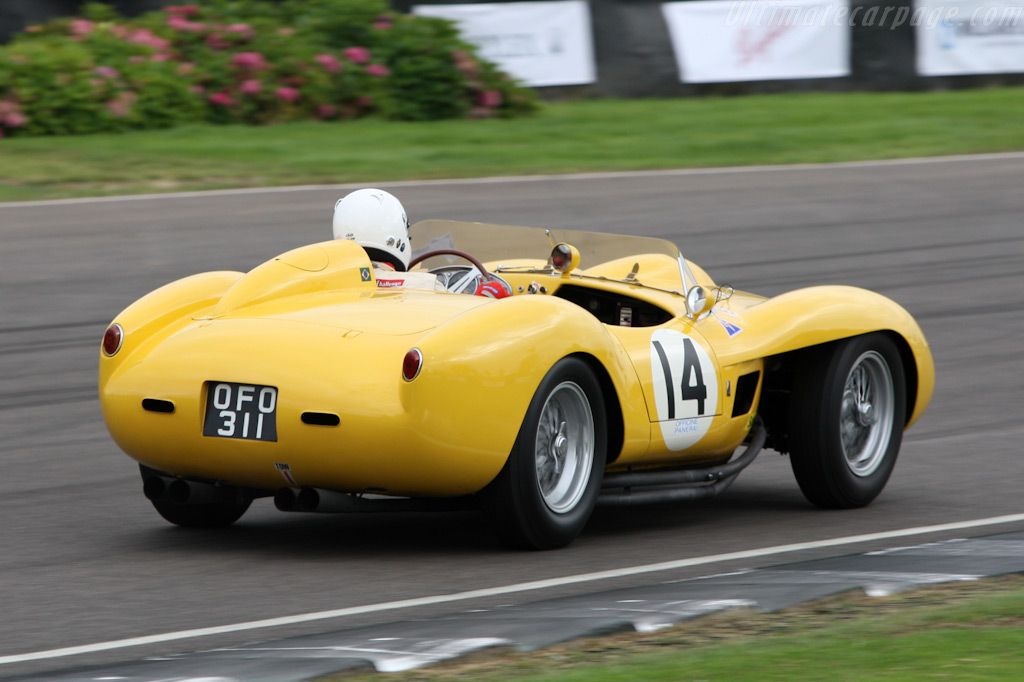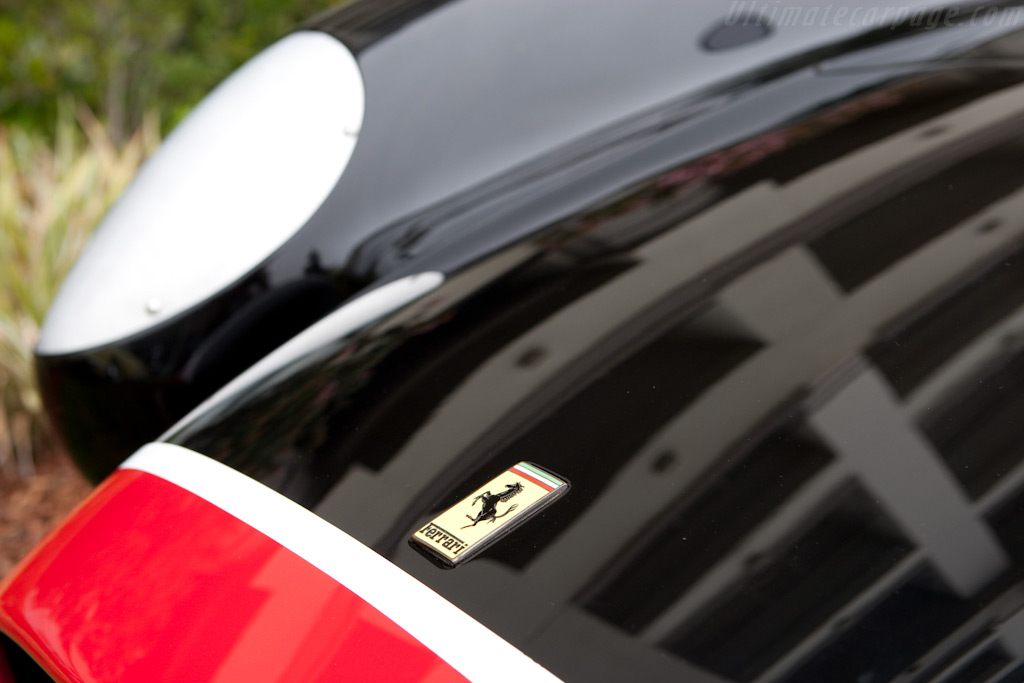

|
| Search | Car Forums | Gallery | Articles | Helper | AF 350Z | IgorSushko.com | Corporate |
|
| Latest | 0 Rplys |
|
|
#1 | |
|
Banned
 Join Date: May 2005
Location: Portland, Oregon
Posts: 2,543
Thanks: 0
Thanked 0 Times in 0 Posts
|
250 Testarossa
Ferrari used to be very involved in sports car racing. The Ferrari 250 Testarossa is a great example of a Ferrari race car.
               Last edited by Jaguar D-Type; 12-12-2005 at 03:42 AM. |
|
|
|

|
|
|
#2 | |
|
Banned
 Join Date: May 2005
Location: Portland, Oregon
Posts: 2,543
Thanks: 0
Thanked 0 Times in 0 Posts
|
Olivier Gendebien and Phil Hill won the 1958 24 Hours of Le Mans in a Ferrari 250 Testarossa
 I think this silver car is a Ferrari 625 TRC            A Jaguar D-Type is next to the red Ferrari  Last edited by Jaguar D-Type; 08-16-2005 at 12:28 AM. |
|
|
|

|
|
|
#3 | |
|
Banned
 Join Date: May 2005
Location: Portland, Oregon
Posts: 2,543
Thanks: 0
Thanked 0 Times in 0 Posts
|
           Last edited by Jaguar D-Type; 08-16-2005 at 12:19 AM. |
|
|
|

|
|
|
#4 | |
|
Banned
 Join Date: May 2005
Location: Portland, Oregon
Posts: 2,543
Thanks: 0
Thanked 0 Times in 0 Posts
|
1957 Ferrari 250 Testarossa Scaglietti
This car was the second of 18 customer cars built with Scaglietti's famous pontoon-fendered design for the 250 Testa Rossa. The car was delivered to a racing client in Caracas, Venezuela, and campaigned extensively in South and Central America before being sold to an American owner in 1959. Today the globe-trotting car has a Japanese owner. - motortrend.com  |
|
|
|

|
|
|
#5 | |
|
Banned
 Join Date: May 2005
Location: Portland, Oregon
Posts: 2,543
Thanks: 0
Thanked 0 Times in 0 Posts
|
1959 Ferrari 250 Testarossa with Fantuzzi bodywork
 |
|
|
|

|
|
|
#6 | |
|
Banned
 Join Date: May 2005
Location: Portland, Oregon
Posts: 2,543
Thanks: 0
Thanked 0 Times in 0 Posts
|
Ferrari 500 TRC
gated shifter like every Ferrari should have    |
|
|
|

|
|
|
#7 | |
|
Banned
 Join Date: May 2005
Location: Portland, Oregon
Posts: 2,543
Thanks: 0
Thanked 0 Times in 0 Posts
|
 |
|
|
|

|
|
|
#8 | |
|
Banned
 Join Date: May 2005
Location: Portland, Oregon
Posts: 2,543
Thanks: 0
Thanked 0 Times in 0 Posts
|
Phil Hill and Olivier Gendebien won the 1961 12 Hours of Sebring.
 |
|
|
|

|
|
|
#9 | |
|
Banned
 Join Date: May 2005
Location: Portland, Oregon
Posts: 2,543
Thanks: 0
Thanked 0 Times in 0 Posts
|
 |
|
|
|

|
|
|
#10 | |
|
Banned
 Join Date: May 2005
Location: Portland, Oregon
Posts: 2,543
Thanks: 0
Thanked 0 Times in 0 Posts
|
Motorsport's governing body, the Commissione Sportiva Internazionale (CSI) was contemplating ways to make sports car racing safer and more popular in the late 1950’s. The fatal accidents in the 1955 24 Hours of Le Mans and 1957 Mille Miglia had dealt the sport some serious blows. In the meantime Ferrari and Maserati were in a tight battle for the world championship with some of the most advanced and powerful machinery seen to date. There was little interest from other manufacturers to enter this highly expensive “two horse race”. British manufacturers Aston Martin and Jaguar, more interested in good publicity than global domination, made a successful exception for the legendary Le Mans race. Throughout 1957 various methods of hindering the cars speed and making the sport more accessible were debated. Eventually a displacement limit was decided upon, but figures mentioned ranged from 3 to 3.5 litres for a while longer. When the final regulations for the 1958 season were announced in September 1957, Ferrari had already been very busy developing and testing their upcoming racer.
Anticipating the upcoming changes, Ferrari set up a new program in the spring of 1957 to run alongside the works assault on the world championship. These highly advanced racers featured large displacement V12 engines with quad-cam heads, matched only by Maserati's 450 S, powered by a quad-cam V8. The first decision to be made was whether to continue on the multiple cam path, or to revert back to the simpler and lighter single cam layout. Simplicity of the engine would greatly enhance the new car's appeal as a privateer racer, but the resulting power loss might hurt the on-track performance. With the current line-up of four cylinder customer racers slowly losing their competitiveness, it was time for a replacement. The latter option was chosen and work began, converting the available three litre engine into a competition monster. At the time this engine was very successful in the 250 GT road racers, but its design dated back to the dawn of Ferrari. The first signs of things to come was a 250 GT equipped with a very hot version of Colombo's V12 that showed a stunning pace in the 1957 Mille Miglia. That engine featured a more aggressive camshaft and timing design and was virtually identical to the road car engine which already yielded an impressive 260 bhp. For the Nurburgring 1000 km race a similar engine was fitted in a 290 MM chassis, which was clothed in a body similar to the 500 TRC. Although hastily assembled, the new prototype racer (s/n 0666) was only slightly slower than the large displacement competition in practice and qualifying. Masten Gregory had moved into fourth before handing the car to a very inexperienced driver, who gradually dropped down the leader board to finish in tenth position. Back at the factory, engine development continued resulting in a 3.1 litre variant thanks to a slightly larger bore. This was just one of many changes, which saw the power grow to 320 bhp at 8000 rpm. A second prototype chassis was constructed and clothed in a Scaglietti designed 'pontoon' fendered body. Equipped with these highly potent engines the cars were entered mainly for testing purposes in the season's remaining races with mixed success. With the complete regulations announced early in September, Ferrari could commence assembly of the independently successful test bits into one car. The conventional steel tubular ladder frame was carried over from the first prototype. The DeDion rear axle was reserved for the works racers, while the customer cars received a live axle. Scaglietti's remarkable 'pontoon' style body was carried over from the second prototype. The reason behind the seemingly separate fenders was to allow for a sufficient supply of cold air to the drum brakes. Its main disadvantage was the increased lift at high speeds and the works cars soon received fully enveloping bodies. The heart of the 3 litre prototype racer was a highly modified version of Colombo's short block V12, of which only the internal dimensions reminded of the 250 GT engine it was derived. The plugs were moved outside the cylinder banks to free up space for separate intake ports and six twin-choke Weber carburetors. To cope with the additional forces the heads now featured four bolts per cylinder instead of the three found on the street engine. Compression was bumped to 9.8 and the engines were rated at 300 bhp. The new racer was announced at the company's traditional November press conference. Following Ferrari's naming policy the 250 TR name was not a surprise; the 250 indicated the unitary displacement and the Testa Rossa, or red (cylinder) head, suffix was carried over from the previous series of customer racers. The British press had a field day bashing the 250 TR for being too elaborate and obsolete from the start with its heavy chassis, ancient engine and drum brakes. Although it might not have been as advanced as Britain's racers, there was little doubt in Maranello that the sturdy 250 TR would be running long after the fragile Coopers and Lotuses had retired. The few remaining critics were quickly silenced after Ferrari started off the 1958 season in dominating fashion with victories in the Buenos Aires and Sebring rounds of the season. The lengthy preparation and development had paid off and the reliability was bullet proof. Sadly Ferrari was the only manufacturer with a racer built specifically for the new regulations and the only competition came from an aging and privately entered Maserati 300 S. The fierce battle of 1957 had proven too much for Ferrari's arch rival who had withdrawn after the devastating season's finale in Caracas, Venezuela. Back in Europe stronger opposition was expected in the upcoming championship rounds from works and customer Aston Martins. The new 3 litre DBR1 racer in particular proved to be a worthy adversary at the hands of Stirling Moss, for as long as its fragile David Brown gearbox would allow for. A genuine season hat-trick was scored at the Targa Florio where the Musso and Gendebien entered TR scored the third victory. At the fourth round of the season, the Nurburgring 1000 km, Ferrari was forced by the organizers to run an inferior brand of fuel. Despite threats from Enzo to withdraw his racers, the Germans did not change their minds and the mechanics were forced to make last minute modifications to the seven 250 TRs present. Despite the changes the V12 engines did not cope with the fuel mixture effectively, leaving the victory for Aston Martin. A second place finish for the fastest Ferrari was however sufficient to clinch the world championship once more. All eyes were now on Le Mans where works and customer racers were aiming to score Ferrari's third victory in the legendary endurance race. Easily identifiable by the enveloping body, the works racers were referred to as TR58 to distinguish them from the customer TRs. Phil Hill and Olivier Gendebien carefully and quickly piloted their TR58 to a well deserved victory with the closest competition a dozen laps or 100 miles behind. Shortly after the convincing Le Mans victory, work was started to continue the TR's dominance. After 19 examples were completed, production of the customer cars was dropped to fully focus on the works effort. In the following years the old works racers would be passed over to the company's most prominent privateers. With these ex-works and the pontoon fendered racers many more (class) victories were scored in minor races. Much of the development work was focused on adopting the racer to the newly acquired Dunlop disc brakes. Little was changed to the engine, although power was up to 306 by adopting coil valve springs, and it was mounted four inches to the left in the chassis in line with a new Colotti designed five speed gearbox. Pininfarina penned a new enveloping body, which was constructed by Fantuzzi, relieving Scaglietti who were pre-occupied with constructing road car bodies. All the work resulted in the TR59, which was considerably lighter and slightly more powerful than its predecessor. With the Argentinean race in Buenos Aires dropped from the calendar there was plenty of time for the new season opener at Sebring. Notoriously heavy on the brakes, it was the ideal location to give the new disc setup a proper test. Teething problems did hamper the entered cars, but it was not enough to prevent the TR59 to score a one-two win at its debut. In most of the European rounds of the championship the Aston Martin works team was present in force and Porsche's nimble racers also formed an increasing threat. The first cracks in the TR's dominance were revealed at the Targa Florio, where the TR59's were beaten both in pace and reliability. The layout of the new five speed gearbox did not suit the low speed track and destroyed the differential on all three entries, leaving an easy victory for Porsche. The gearbox proved troublesome at Le Mans again, but for different reasons. Although the April test days had shown the cars to be under-geared, there surprisingly had been no adjustments made for the race, so the driver's were told to back off on the straights. Before the race the drivers were told to rev the engines no higher than 7500 rpm, but as soon as the flag dropped they all seemed to have forgotten the team leader's instruction. After a poor start, Jean Behra had stormed to the lead, continuously recording faster lap times. At his first pit stop the telltale needle on his rev counter showed 9300 rpm and ten hours into the race he was out. His team mates also ignored the instruction and with four hours to go all three works cars were out of the race. After the Nurburgring win a few weeks earlier, Aston Martin finally added the much desired Le Mans race to their victory tally. Although a privately entered 250 GT scored valuable points for Ferrari, it proved to be insufficient to keep the British team from the world championship. Only minor revisions were carried through on the TRs for 1960, mainly dictated by the slightly changed regulations. The only technical changes were seen on the gearbox of which various versions were tested and raced throughout the season. Three of the five TR59s were retained by the factory and updated to the new specification and are commonly referred to as TR59/60. At the Le Mans test day the fully independently sprung TRI60 was first campaigned. This highly advanced racer was considerably lighter than the regular TR59/60s and offered better cornering characteristics. The championship only consisted of five rounds this season and with the withdrawal of Aston Martin there was no factory opposition for Ferrari. The first championship victory by Ferrari in almost a year came in Buenos Aires. The Scuderia boycotted the Sebring 12 Hours race because they were forced to run the sponsor's fuel much like at the Nurburgring two years earlier. A privately entered TR59 scored four useful points behind the victorious Porsches. The Targa Florio and the Nurburgring 1000 km races again did not favour the TR and victories were scored by Porsche and Maserati respectively. At Le Mans the order was restored and with a one-two victory Ferrari regained the championship crown beating Porsche by four points. Although the Ferraris were competitive in the last two seasons, the dominance of 1958 seemed so far in the past so more drastic alterations were required. Although still referred to as a Testa Rossa the TRI61 featured a completely new spaceframe chassis. The name is still somewhat justified as much of the suspension and drivetrain from the ill-fated independently sprung TRI60 was adapted. The spaceframe was not as elaborate as the one that gave the Maserati 'Birdcage' its nickname, but still offered superior weight and rigidity characteristics over its predecessors. The most obvious changes for the spectators was the new body style complete with a sharknose front and Kamm-tail for more stability. To more successfully take on Porsche on the tighter tracks the large TRI61 was joined by the nimbler, mid-engined 246 SP at the annual press conference. Ferrari's tactics paid off and with victories for the TRI61 in the Sebring 12 Hours and Le Mans 24 Hours and one for the 246 SP in the Targa Florio, the title came home with Enzo once again. The CSI stepped in once more and drastically changed the regulations again. For 1962 the world championship would be run for GT cars and although prototype racers like the Testa Rossa were still allowed to race for overall victory, they were no longer eligible to score points. Following the rule changes, the prototype program was frozen in favour of the new GT car developed. Powered by the six carb TR engine, this 250 GTO owed much to its world championship predecessor. A new four litre 'experimental' class was created, but with much stricter regulations than the previous three litre prototype class. Many of these changes involved mandatory equipment such as full windscreens with wipers to resemble road cars more accurately. After many of the key personnel walked out in the winter of 1961, there was little time and desire to develop a new racer to suit this class. Work eventually began, but proved too late for the season opening Sebring 12 Hours. The chassis was derived from 250 TRI60 s/n 0780 TR, renamed 330 TRI/LM and renumbered 0808. It was stretched to house a four litre Superamerica engine that was tuned to develop a conservative 360 bhp. The car was ready for Le Mans where its only real opposition came from a fragile Aston Martin. With the TR's most successful drivers behind the wheel there was little doubt that a fourth Le Mans victory was on hand for the Testa Rossa. Phil Hill and Olivier Gendebien yet again showed their worth and promptly piloted the 330TRI/LM to Ferrari's sixth Le Mans triumph. It was the last major victory for the TR and also the last at Le Mans for a front engined racer. In the 19 championship races the 250 TR variants were entered between 1958 and 1961, a remarkable 10 victories were scored. With the exception of the troublesome 1959 season there was no stopping V12 engined racers. It is debatable whether the successes were scored due to the lack of competition, or the TR's stellar pace turned the competition away from building a competitive racer of their own. Regardless, what matters most is the car's racing record; the hows and whys are quickly forgotten. Today the Testa Rossa name and the pontoon fendered shape of the early cars are highlights in Ferrari's long history. With only 34 examples of all versions constructed and even less remaining today, the TR is also one of the most valuable of all. Scaglietti bodied all of the production 250 TRs (19 of them). Scaglietti-bodied 250 TRs are shown below. - ultimatecarpage.com 3.0 liter 300 hp V-12             |
|
|
|

|
|
 |
POST REPLY TO THIS THREAD |
 |
|
|